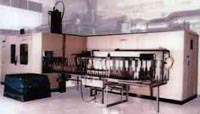|
Electrostatic Colour Coating System |

A REVOLUTIONARY APPROACH TO GLASS DECORATION
The Electrostatic Coating System is by far the most cost effective method of applying colour coating to glass. It offers a virtually infinite range of colours, opacities and textures, high dishwasher resistance and is suitable for a wide range of products including bottles, cosmetic containers, tableware, lighting glass and decorative glass. The only limit is the imagination of the user!
The system employs a high voltage charge which carries the coating particles to the pieces to be decorated. It gives a very even, fully controllable coating thickness of 10 to 20 microns and can be controlled to + 5 microns.
This degree of coating accuracy is not achievable by any other coating process. Because of the high efficiency of the electrostatic process, material usage is as high as 95% compared with as low as 20% for conventional aerograph spray processes.
After coating, the piece is cured in the integral oven at 160°C to 200°C giving a durability which will withstand many washing cycles in a domestic dishwasher - often many times the typical working life of a tumbler!
Because of the efficient use of the coating material, the process is highly cost effective. It can cost as little as US$0.01 in materials to coat a small cosmetic bottle with a bright colour!
Because the process is fully integrated, coating and curing takes only 10 to 12 minutes and, depending on the machine specification and the size of the piece, the process can achieve speeds of up to 120 pieces per minute.
The equipment comprises a continuous track, a coating chamber and a curing oven which is contained in a single housing and occupies a floor area of only 5 x 8 metres. Depending on operating speed, it can be operated by as few as 2 or 3 operatives to load and unload the ware.

The special paints, developed in the UK, are free from all heavy metals and are available as either solvent-based or water-based. The solvent-based products offer the highest levels of durability whereas the water-based products offer the advantage of easier clean down.
We offer a full service which includes the equipment, coating materials, commissioning service and full on-site and off-site training.
PRODUCT LIST
Solid Colours
1 Solid Colours
High quality primary and blended colours in full Pantone range. Colours have sufficient opacity to cover green and amber glass as well as flint.
2 Transparent Colours
Full range of strong colours as well as pale tints. Solid colours and transparent colours are a highly cost effective alternative to forehearth and furnace colouring.
3 Simulated Acid Etch Colours
Acid etch or sandblast type finishes in a range of pastel or solid colours as well as the natural etch finish.
4 Pottery Finishes
Range of simulated ceramic and stone-type finishes with textured surface and colour range from light stoneware to terracotta.
5 Metallic Colours
Full range of colours containing special additives to give a metallic effect. Range includes bronze, antique bronze, gold and silver finishes.
6 Fluorescent Colours
Range of bright colours that glow under ultra violet light.
7 Luminescent Colours
Colours that absorb then emit light over a long period.
8 Iridescent Colours
Solid or semi transparent colours which show hues of lilac and green at their edges. Similar effect to oil on water. Used for decorative glassware, lighting glass and cosmetic containers.
9 Pearlescent Colours
Similar to iridescent except that effect is best observed on solid colours, particularly white and cream, where hues of pink, lilac, blue and green are observed around the edges of rounded objects where light reflects at an acute angle, similar to 'mother of pearl'.
10 Photochromic Colours
Colours which change according to the nature and intensity of the light source under which they are viewed.
11 Thermochromic
Temperature sensitive colours which change when they are chilled or warmed (depending on formulation). Very effective on glass tableware and drinks bottles.
12 Soft Feel Colours
These colours give a non-slip rubber-type feel and are available in a full range of solid colours.
13 Ultra Violet Blocking colours
UV blocking additives can be included in certain colours. They greatly enhance product shelf life by acting as a barrier to UV light. We also offer transparent UV barrier coatings which allow product show-through.
ELECTROSTATIC COATING v FOREHEARTH/ FURNACE COLOURING
|
|
|
||
| Colour range: | Achievable | Blue to Green; Pink, Amethyst, Light Brown, Grey and Black | Infinite range of transparent and opaque colours, simulated acid etch colours, pottery finishes and a wide range of special finishes including metallic, fluorescent, thermochromic, photochromic, iridescent, etc |
| Limitations | Cannot produce Red, Orange, Yellow, furnace colour Amber, White or any opaque colours other than Black. | None | |
| Colour changeover | 8 to 24 hours | 10 to 15 minutes | |
| Indirect costs | Glass produced during colour changes is scrap. Cannot be used as cullet. | None | |
| Installation | Major structural alterations to forehearth steelwork, replacement of forehearth crown blocks and possible changes to forehearth channel shape. Forehearth shut down whilst work completed. Installation of feeder mechanism to side of forehearth. Installation of stirrer drive units and lifting mechanisms above forehearth. Installation of control panel at side of forehearth. | Off-line free standing unit. No affect on production. | |
CERAMIC AND ENAMEL COATINGS
In addition to using organic coatings, the Electrostatic Coating Process can be used to apply glass enamels, glazes and on - glaze colours to glass and ceramic substrates. Material transfer efficiencies are very similar to organic systems making them very economical to use by minimising wastage. In addition, coating thickness is very accurately controlled. These two major advantages make Electrostatic Coating far more cost effective than either aerograph spraying or dipping processes.
Electrostatic Coating Technology is the most versatile and cost effective method of applying a wide variety of coating materials to almost any regularly shaped component.
